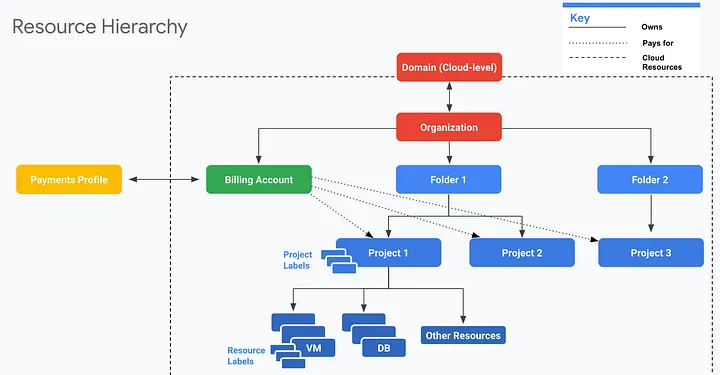Getting Started with Google Cloud
 Samiksha Patil
Samiksha Patil
In the ever-evolving landscape of cloud computing, effective resource management is crucial for businesses striving for efficiency, scalability, and security. The Google Cloud Resource Hierarchy is a fundamental concept that plays a pivotal role in organizing and managing resources within the Google Cloud environment.
What is the Google Cloud Resource Hierarchy?
At its core, Google Cloud Resource Hierarchy is a structured way of organizing resources within the Google Cloud Platform (GCP).
The primary components of this hierarchy include organizations, folders, projects, and individual resources.
Purpose:
1. Provides a hierarchy of ownership which binds the lifecycle of resource to its immediate parent hierarchy.
2.Provides attach points & inheritance for access control and organizational people.
(#for understanding...GCP resource Hierarchy = File system found in traditional OS)

Key Components of Resource Hierarchy
Organization
An organization in Google Cloud is the top-level container for resources. It serves as the anchor point for managing billing, policies, and permissions. Organizations provide a global context for all resources within them.
Hierarchy Root: The organization is the root of the resource hierarchy. All resources and projects within the Google Cloud Platform are organized under an organization.
To check the organization with your GCP account, use the following command:
gcloud organizations list
Folder
Folders are used to group resources within an organization, offering a way to structure projects and control access to resources. They provide a flexible means of organizing resources based on your business needs.
Hierarchical Organization: Folders can be nested within each other, creating a hierarchical structure. This hierarchy allows for the logical organization of resources based on departments, projects, teams, or any other relevant criteria.
To check the folder with your GCP account, use the following command:
gcloud resource-manager folders listFolders are typically created and managed through the Google Cloud Console. Administrators can navigate the console to create, rename, or delete folders, as well as to assign resources to specific folders.
Projects
Projects act as containers for resources and are created within folders or directly under the organization. They provide isolation, allowing you to manage resources independently. Projects are the building blocks of the resource hierarchy.
Project has 3 components:
Project ID- chosen by user-globally unique- Immutable(can't change)
Project name-chosen by user-not required globally unique- Mutable(can change)
Project Number-assigned by GCP-user-globally unique- Immutable(can't change)
To check the folder with your GCP account, use the following command:
gcloud projects list
Resources
Resources represent individual cloud components such as virtual machines, databases, storage, and more. They are organized within projects and can be assigned specific roles and permissions.
Resource Types: Google Cloud offers a diverse set of resource types, each designed to fulfill a specific purpose. Examples include Compute Engine instances, Cloud Storage buckets, Cloud SQL databases, and more.
Configurable Settings: Each resource type comes with configurable settings, allowing organizations to tailor the behavior and characteristics of the resource. These settings can include specifications for performance, capacity, access controls, and more.
NOTE
All the GCP resources you use are associated to one specific project.
You can track resources and quota usage.
Enable billing and set usage.
Manage permissions and credentials.
Project is global entity.
Project is equivalent to account in AWS, subscriptions in Azure.
Subscribe to my newsletter
Read articles from Samiksha Patil directly inside your inbox. Subscribe to the newsletter, and don't miss out.
Written by
